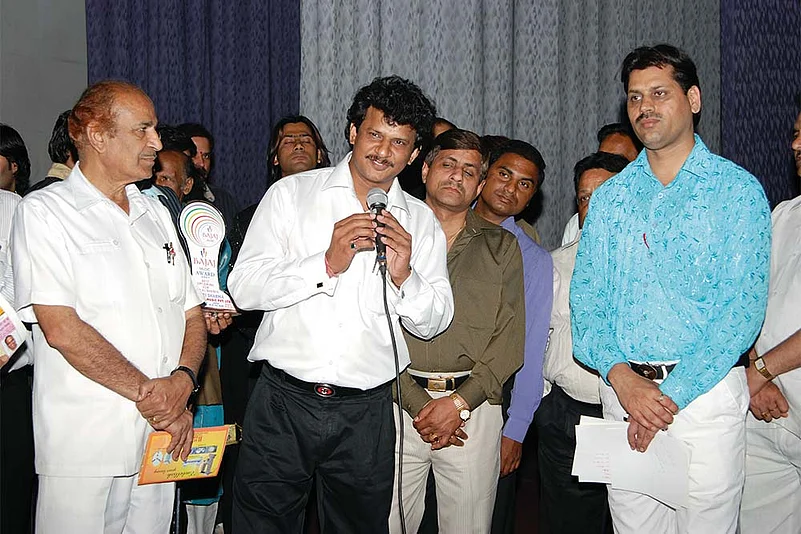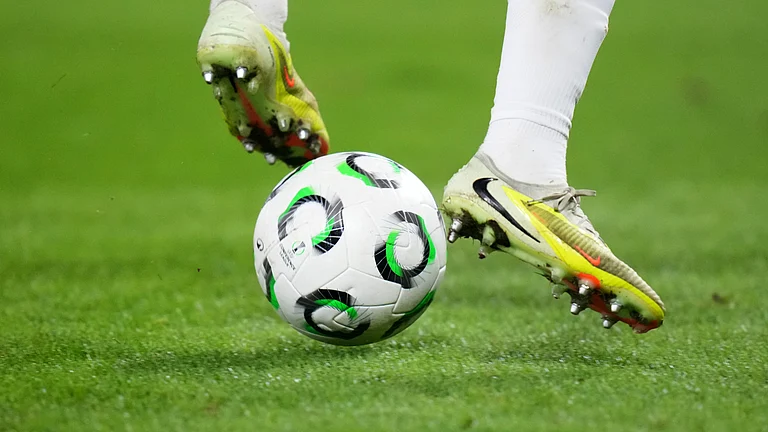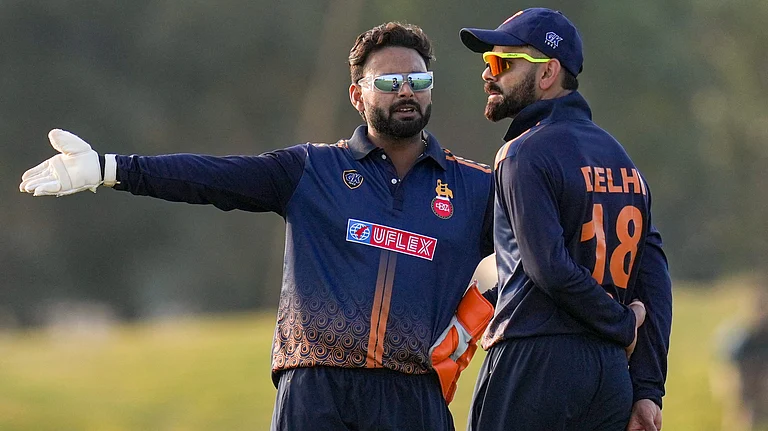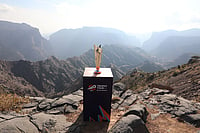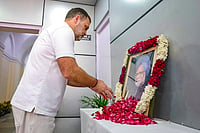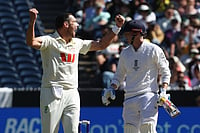Bijender Chauhan is a tremendously popular singing icon, with over 3,000 albums to his credit in a three-decade-long career. He has a massive repertoire of devotional songs and hopes to make it in Bollywood as a music director. But while Chauhan has spent his life in and out of recording studios, when he talks about himself, he uses analogies befitting an athlete. “I have run very fast in life,” Chauhan says. “A person with both legs could not beat me in this race.” He refers to his struggles after a motorcycle accident at age six, in which he lost the use of a leg. The experience blighted his childhood, made him housebound, and introduced Chauhan to crutches, callipers, intense pain and appalling insensitivity. In his late teens, his family thought of marrying him off to “a girl from a poor family or a widow”. They expected him to do no more than run a grocery shop from home.
Overcoming persistent prejudice through hard work, Chauhan made it through school, college and trained under a guru he reveres. The prosthetic limb attached at his hip, after 12 hours of wear, causes intense pain and discomfort, but he has never missed appointments. The real test of his mettle, he feels, was not making it big but simply getting around. A prosthetic limb has nuts and bolts and screws that occasionally get broken or damaged, rendering someone like Chauhan helpless. Nor can he access public transport or ambulance services. Today, he doesn’t wish for anything different, but he does wish there were fewer steps leading up to every building, more lifts and easier ways to access basic amenities. Not just for himself, for he is now chauffeur driven, but for millions of physically disabled who need a leg up.
Barrier-free infrastructure, accessible civic facilities, audible traffic signals, pavements with ramps, accessible toilets...India’s disabled, said to make up anything from two to ten per cent of the population, are waiting for a 1995 law to be implemented so that the road to development is paved with services that cater to them. Also in the works is a new Disability Rights Bill, which covers 17 instead of five disabilities defined in the present law, and expands the scope for accessibility in public spaces. That law, hanging fire since 2014, was recently reviewed by a group of ministers.
“The delays in bringing this law are a matter of concern,” says Javed Abidi, a disability rights activist who lobbied with the government for it. Abidi is wheelchair bound from a spinal condition, without access to most public or private spaces. “In 2014, BJP leaders told us they will bring this law within six months,” he says. Since then, there have been two references to disability in the PM’s Mann Ki Baat radio address, and several other mentions in his speeches. The government even has the slogan Accessible India, which creates a buzz about making buildings that can be entered without hindrance. However, the buck stopped there and activists like Abidi are unable to connect the government’s effort with its intent. “The fate of the disabled does not change by giving away 11,000 wheelchairs to the disabled in Gujarat nor by handing out hearing aids to the deaf. We feel the government is focused on the glamour quotient of disability--giving hand-outs and jazzy events, but on hard policy matters, it’s going nowhere,” he says.
If India has success stories to show in the recent Paralympics, it’s not because government or society at large made it easy for sportspeople to get around. It is because, like Chauhan, each Paralympian struggled independently against the odds. Not just that, for the physically invalid, access covers the entire breadth of physical infrastructure and services, including their right to employment.
Neha Arora runs PlanetAble, a specialty tourism outfit for the disabled. Last month, she took a group to Qutub Minar in Delhi but it took two prior visits just to ensure that the accessible toilets were in order. They were not. “It took two visits to figure out who had keys to the accessible toilet. And it didn’t have side-support rails. Plus the door wouldn’t open fully,” she says.
Depending on whom you listen to, the UN or the official Census of 2011, there are 70 million to 26 million disabled persons in India. “We know disability and economic status are linked. Arguably, the poorer you are, the worse impact disability has,” says Uma Tuli, who heads Amar Jyoti, an NGO that works for rehabilitation of the physically challenged. Tuli says the law aside, not enough people recognise that young people with diabilities (PWDs) are as capable as other students. “This is because there’s a kind of segregation—the two groups never meet or interact.”
Rampyari, a 48-year-old polio sufferer, struggled for years before her university in Rohtak installed a ramp for her to reach her desk. From a humble background in rural Haryana, where she was married off young to a drunk, she educated herself and started work as a receptionist over a decade ago. She now holds a position at the inquiry desk of M.D. University. “University authorities would not build a ramp for me to enter the building on crutches. I would have to wait for somebody to come and lift me over the steps,” she says. Today, the building has a ramp, but Rampyari cannot access any other campus building. Though she wanted to teach, and holds a Masters in Hindi, she didn’t pursue an MPhil. “I kept my dreams on hold,” she says, “Because my movements were so restricted. How would I ever go into the library, or into different classrooms?”
Major H.P.S. Ahluwalia, who suffered a bullet injury in the 1965 war, acknowledges the healthy buzz around the Paralympics, but delays on the law that should have come up to help the disabled disappoints him. “All classes of people suffer greatly from disability. But we should not look at an access ramp, for instance, as if it is only for the disabled. It is, in fact, a service for all...for a child, for a mother carrying a baby, the old and infirm,” says Ahluwalia, who set up the Spinal Injuries Centre, a specialised healthcare-rehabilitation hospital in Delhi in the 1980s.
Despite having helped thousands rehabilitate, India doesn’t have a clear rehabilitation policy, and that has immense hidden costs. “Not just the disabled, even their caregiving family pays an economic cost. The disabled must be trained to work and given a shot at independence, but how, if they cannot even enter office buildings,” he says.
This is why the new law proposes a five per cent reservation for PWDs in government jobs, a slight increase over the current three per cent. This, however, is said to be one of the sticking points holding back the new law altogether. “It will be cleared when the government gets absolute majority. It is caught between the BJP and the Congress,” says Kamlesh Pandey, chief commissioner for disabilities, government of India. He says, “India gives divyang persons rights and respect. How else did Dhritrashtra become king? Now we also want to give the divyang basic services.”
That is scant reassurance for Prof Yogesh Chaurasia, a visually impaired teacher of political science at Delhi University’s Maitreyi College. Chaurasia does not consider teaching senior classes at Delhi University due to an almost complete lack of access to public transportation.
Chaurasia’s disability, one might say, extracted other heavy costs, for it also created a rift between his family and him. “The usual prejudice against blind people is that we are expected to be music teachers, nothing else. Despite an MPhil in political science from JNU, I was told to teach music. Now, if I say I teach, people still assume my subject is music. I detest it and prefer the company of my friends in Delhi to family back in Lucknow,” he says. He has also come to dislike music as a result of this prejudice being thrust on him ever since childhood.
“The single biggest obstacle confronting a society that seeks not to discriminate against the disabled is that of attitude,” says Jayashree Raveendran, who runs the Ability Foundation. Sadly, while we can mandate laws, we cannot mandate people’s attitudes. “There is a tendency to view a person with disability as deprived or not normal and therefore we have condescending phrases as ‘differently abled’ and ‘specially challenged’,” she says.
The insensitivity and lack of regard doesn’t just stay within schools and drawing rooms. It spills over to administration and governance, where discrimination and neglect have taken deep roots. For example, Delhi University’s flip-flops from the semester system to annual exams, hits persons with disabilities the hardest. “Important books in Braille or audio are rarely available. Then, they switch between teaching systems without considering us. Frankly, sometimes, it’s as if we simply don’t exist,” says Chaurasia.
By Pragya Singh

Deepa Malik: The Chair Was Not A Hindrance
“The ‘D’ in my name actually stands for ‘determination’,” Deepa tells Outlook. She threw the shot-put to 4.61 metres, her personal best, to clinch silver, missing the gold by a mere 15 centimetres in Rio. The woman who overcame two bouts of crippling tumour says that being gritty is an “innate habit”.
“The Almighty prepared me for this journey by giving me the first tumour at the age of six. For a year, I was bedridden, followed by surgery. It was a gruelling process. But the illness helped me imbibe all these qualities and a positive attitude,” says Deepa. Yet, far from being bogged down, Deepa is a fun person. After recovering fully, she led a full life. “I had a very normal growing up thereafter. I had great teenage years—very brattish, tomboyish years. I am lucky to have been married to a person (Bikram Singh Malik, also her skill coach) who never objected to the flamboyant and adventurous streak I had. And then the tumour came back to physically challenge me all over again,” she recalls.
Indeed, when Deepa’s tumour recurred in June 1999, it was a crippling blow. But she was lucky so far as medical treatment was concerned. “It was the time when the soldiers wounded in Kargil were being treated here in Delhi by doctors and experts who had come from all over the world. It was the right time and that was probably why I got saved; also, the best of medicines were available.” Now, her two daughters—Devika (25) and Ambika (21)—are set to extend the family’s legacy in sports.

Devendra: Throw That Went Farthest In The World
His greatest achievement is perhaps not that he returned after a 12-year gap and won a second Paralympic gold in javelin throwing at Rio. About two years ago, Devendra Jhanjharia’s knees had almost given in and doctors in Jaipur had advised surgery. Instead, Devendra, whose left hand is amputated below the elbow, opted for a set of exercises as alternate treatment. In Rio, Devendra broke his own world record with a 63.97-metre throw. His previous record was 62.15 metres, set at the 2004 Athens Paralympics. The gold was for keeps.
“For two years, he did the recommended exercises rigorously; that brought strength back in his knees. He was fitter than before. When we trained for 81 days in Finland before Rio, we measured his 30-metre timing, as part of measuring his fitness, and found his speed had increased,” reveals Sports Authority of India (SAI) coach Sunil Tanwar. “He was earlier clocking 4.10 sec; now it was 3.90 sec.”
Tanwar, now at the SAI centre in Hisar, Haryana, says Devendra’s improved fitness—and conditions in Finland—encouraged him to increase his workload. To Devendra’s horror, at times Tanwar pushed up the training schedule to seven hours a day. But the tough training bore fruit in Rio. Credit is also due to senior physiotherapist G.B. Sethy at SAI Centre, Gandhinagar, where the Rio Paralympic-bound athletes trained. Devendra, an Arjuna (2004) and Padma Shri (2012) awardee, is the first Indian Paralympic athlete to win gold at a world championships in any sport, in in Lyon, France, in 2013.

Varun Singh Bhati: Bronze And A Hindi Coach
He had twin responsibilities in Rio: to perform well in high jump—he eventually won bronze—and play Hindi teacher to eventual gold medallist Thangavelu Mariyappan. Their coach Satyanarayana, too, was working on twin aspects of his wards: ensure, quite literally, that they reached greater heights and that Mariyappan learnt some Hindi on the way.
Bhati, whose left leg is polio-affected, took up high jump in 2010 while studying at the St Joseph Senior Secondary School in Greater Noida. He won the gold at the China Open Athletics Championships in 2014.
Bhati won the high jump bronze in Rio with a personal best of 1.86 metres. He also managed to teach a few Hindi words and sentences to Mariyappan, says Satyanarayana. Interestingly, the two athletes are fierce rivals on the field; off it, they are close friends who spend a lot of time together.
“I want Mariyappan to learn Hindi, because it is the essential language for communication everywhere in India. That’s why I deliberately put him with Bhati, who speaks Hindi fluently, as he is from North India (Greater Noida/Delhi), in one room. That way, he would be able to learn Hindi from a native speaker,” explains Satyanarayana. The coach says one advantage with Bhati is that he’s a ‘cool and calm’ person and that helps in ‘teaching’, no matter what the subject.
Although Bhati, who used to earlier play basketball before switching to track and field, can’t speak Tamil, his brief is to teach as many Hindi words to Mariyappan as possible.
“Also, I keep telling him to watch more and more Hindi movies and Hindi TV channels so that he learns it quickly,” says the coach.

Mariyappan: The Man Who Jumped To Gold
Having clinched the high jump gold with a leap of 1.89 metres, the unassuming Mariyappan, perhaps on the advice of bronze medallist Varun Singh Bhati, decided to go for a makeover on the last day of the Paralympics. When he emerged from the salon, he sported a razor-cut hairstyle. Mariyappan, otherwise diminutive, virtually defies gravity when he puts those spikes on. He beat Sam Grewe by three cms, with the American jumping 1.86 metre.
But it is the Mariyappan’s dramatic story that is worthy of a biopic. Coming from a small village, Omalur, in Tamil Nadu’s Salem district, he didn’t let misfortune get the better of him.
Coach Satyanarayana, who was impressed by him during the 2013 Nationals in Bangalore, says he comes from a very poor family. His mother first worked at a brick kiln; she now sells flowers and fruits, going from village to village. Like Deepa Malik, Mariyappan had survived an accident. “When he was a kid, a bus ran over his leg in Salem. That was about 15 years ago. But he survived,” Satyanarayana, a 1,500m and 3,000m former runner, tells Outlook from Rio.
Satyanarayana convinced Mariyappan’s family to let him take their talented son along with him to Bangalore for training. “I convinced the family that I would arrange for and ensure a fixed monthly income for the family. I have some connections and arranged a monthly income for Mariyappan’s family, and trained him,” he says. The rest of his career was crowned with a glorious gold in Rio. That is set to change the lives of Mariyappan and his family. The razor-cut hairstyle is just the beginning.
By Pragya Singh and Qaiser Mohammad Ali






